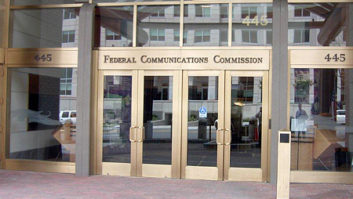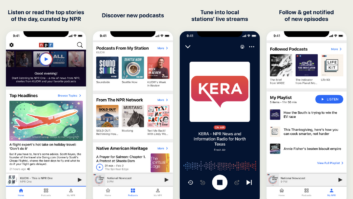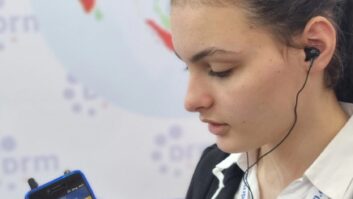Everyone wants their media mobile nowadays, anywhere and anytime. Small form-factor (SFF) devices like multi-function PDAs, smartphones and iPhones have come a long way quickly.
But according to Kevin Kahn, senior fellow for Intel Corp., they still have a long way to go to become truly user-friendly for consumers.
In a Super Session during last month’s NAB Show, Kahn scolded today’s offerings as too limited, offering only local apps. They have a fixed and often confusing I/O and are generally unaware of their surroundings.
His vision for tomorrow’s do-everything mobile devices includes a fully integrated Internet experience with interactive Web applications, voice recognition I/F, nearby device-driven I/O and location relevance, plus fully wireless sync.
Get smarter
Harnessing these new capabilities is a work in progress and will depend on higher computing and graphics power engineered into the SFF devices.
Radio-equipped smart sensors will be needed that detect peripheral devices around them that can make the user experience more adaptable, unique, enjoyable and productive. And these devices should anticipate what the user wants to do with the peripheral, whether it be a larger display, a printer or scanner, or an A/V center.
For example, Kahn suggests any full-featured SFF mobile device should be able to sense that a larger nearby video screen is available for use in a conference room, or the seatback display on an airplane.
Wires should not be necessary and auto discovery with a smart I/O would connect the two automatically after authentication. Carry Small/Live Large (CSLL) will be the mantra and new definition of mobility that will drive research and development into this realm of opportunity.
Making CSLL real will force the size of laptops even smaller while at the same time, require them and pocket devices to carry more computing power and more communicating capabilities that do not require wires and connectors.
There are simply too many wires and too many different connectors that challenge and confuse the consumer experience of personal electronic devices, he argues.
Kahn described some of the technology challenges on which Intel is working that are needed to enable CSLL more quickly.
The new devices must integrate multi-radio functionality so that the various standards being used can be supported. Wi-Fi, 3G, WiMax and Bluetooth have their own bands and modulation schemes. Most of the progress in this arena has been driven by digital technologies, but the basic radio designs are still mostly analog and not scalable.
Intel is investigating how best to integrate automatically tuned antennas and front ends that will cover the two primary bands now used for mobile devices.
Tomorrow’s radios all need to be “softer,” with functionality that can be changed by a software I/O. And they also need to be “quieter” so that the RF interference they emit like the GSM cellphone “cricket chatter” is reduced. This will be important so that peripheral device sensors can work reliably.
Mobility and DTV
In summarizing, Kahn noted that for CSLL to become reality, mobile devices need to discover any nearby larger display or peripheral device, securely authenticate and connect to it and then communicate the video or other data required.
They also need to be able to “wake up” sleeping devices and have positional awareness.
He also noted that better industry cooperation and the forging of standards on which all manufacturers can depend will be vitally important. Too many approaches are being used when innovative ideas are brought to market. More cross-company collaboration and even consolidation will be necessary, he said.
A roundtable discussion followed Kahn’s presentation and was moderated by Rick Ducey, chief strategy officer of BIA Financial Network Inc.
Brandon Burgess, chairman/CEO of ION Media Networks, identified mobility as the third leg of DTV. “The under-30 crowd is using mobile video heavily,” he said. Users expect their small mobile devices to offer TV programming and quality along with everything else now available over the Internet.
Jason Hirschhorn, president of Sling Media Entertainment Group, who helped launch the popular and innovative Slingbox, observed that users want to be able to use mobile video anywhere, anytime, and don’t care what the source of the programming is or how it’s being delivered. He thinks better device navigation schemes are needed.
Tara Maitra, vice president and general manager of programming for TiVo, noted that DVR is now being thought of as a “digital video retriever” and said that TiVo is not just for the living room anymore. “TiVo to Go” is being made to function across mobile devices.
University of Southern California Entertainment Technology Center Executive Director David Wertheimer suggested that the industry has to focus on the consumer/user experience first.
“We need to do the careful research on what consumers really want and then make devices that deliver those needs.” He suggested that watching a full-length movie on a cellphone is not all that interesting and may not be in demand.
Success models
Gary Gannaway, CEO of WorldNow, described how WorldNow is providing video streams to millions of connected users from many sources. Just as Baskin-Robbins accelerated ice cream from two standard flavors up to 31, WorldNow is conveying much more of the video from newsroom operations to consumers using mobile devices, and not just the selected short clips seen on-air.
While most of the panelists agreed that standardization is important to enable faster adoption and growth of mobile video, Sling Media’s Hirschhorn offered a counter-observation. Any hot new idea has to remain veiled in secrecy before it is launched as a product to the market. If it is truly successful, then it might be considered for standardization.
Ducey observed that new technology products must be given the chance to fail or succeed in the marketplace but then cited a different model. Apple has had tremendous success with its proprietary closed “eco-system” that is vertically integrated, including such innovations as iTunes, iTV and the iPhone.
Consumers want to be able to use the DVD or digital movie they paid for on their mobile devices in addition to their living room entertainment centers. To transfer it into their mobile player is difficult and is limited by licensing and copying restrictions.
Hirschhorn contended that when content providers make their product inflexible and hard to use, they breed piracy. Ducey agreed and suggested this is a large hurdle the industry needs to overcome in finding a fair value/pricing relationship for content.
The panel concurred that the traditional advertising-supported model is challenged because it has become so easy to skip over embedded ads.
The discussion ended with Hirschhorn’s observation that traditional businesses are structured on management and maximizing cash flow. They follow the money.
New-tech businesses are structured on innovation and they follow the consumer. When a new-tech business becomes successful and eventually traditional, it must follow both.












